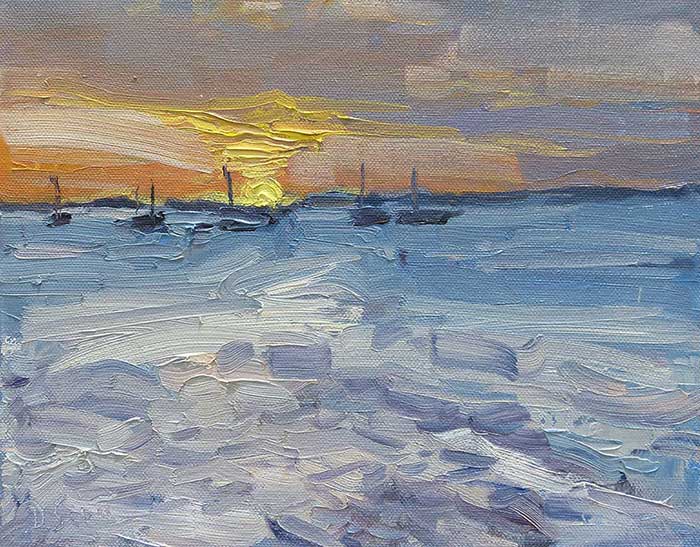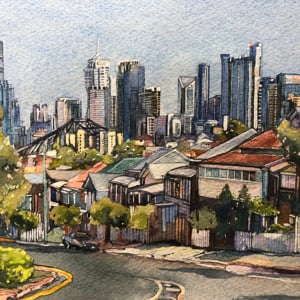What Does Painterly Mean?
Painterly is a term that describes a set of qualities that are perceived as being distinct to the art of painting. These qualities include the use of color, stroke and texture.
The term was popularised by Swiss art historian Heinrich Wölfflin, who used it to describe the characteristics of paintings.
A painting may be described as being painterly when the illusion of form is created by utilizing colors, strokes, textures and any other techniques unique to the art of painting, rather than a linear method involving skillful drawing. In simple terms, it is used to describe a painting that looks like a painting.
- What Does Painterly Mean?
- Tips for a Painterly Style
- Examples of Painterly Art
- Learn More
- Thanks for Reading!
Below is one of my most painterly works. Notice the visible brushwork and simplified detail.

Artists with a painterly style include Vincent van Gogh, Claude Monet, John Singer Sargent and the late Richard Schmid. On the other hand, artists with a more linear and realistic style include Michelangelo, Sandro Botticelli and Jean-Auguste-Dominique Ingres. I feature some examples of painterly art at the end of this post.
Tips for a Painterly Style
Here are some tips for creating painterly art:
- Use larger brushes. This will help you paint with more economical and prominent strokes.
- Emphasize certain elements in favor of your idea. For example, if you are painting a vivid sunset, then push your colors warmer, brighter and more intense than they actually are. If you are painting the rough terrain in the landscape, then paint with thicker texture.
- Try to paint with a level of instinct, rather than only making calculated decisions.
Examples of Painterly Art
Here are some examples of paintings that I consider to be painterly. In Camille Pissarro‘s painting below, observe the bold strokes and lack of fine detail. These are key features of a painterly style.

Monet is renowned for his expressive and painterly brushwork to capture the essence of the scene. In the painting below, notice the swirling brushwork he used for the smoke and the broken color he used to paint the rough ground. Also, notice how he really pushed the use of blue.

In Henri Matisse’s painting, you can clearly see all the strokes of color. Even for the less important areas in the painting, like the wall and the desk, you can see varied colors, brushwork and texture to create interest.

In Joaquín Sorolla’s painting, notice the bold and directional strokes used for the water and grass. This gives the painterly appearance and helps to draw your eyes around the painting.

Simplified shapes are another key feature of a painterly style, as demonstrated in the painting below.

Take a look at the detail used for the two subjects in this painting. They almost blend in with the white tablecloth. Also, the trees and plants are really nothing more than a build-up of broken color and texture; Sergey Vinogradov made no effort in painting all the individual branches and leaves.

Learn More
If you want to learn more about creating painterly art, then you should read my post on the visual elements, which are the building blocks of painting.
Thanks for Reading!
Thanks for taking the time to read this post. I appreciate it! Feel free to share with friends. If you want more painting tips, check out my Painting Academy course.
Happy painting!

Dan Scott
Draw Paint Academy







Thanks! I teach a small informal class and I struggle to get them to understand that art making is not accurate portrayal of what already exists. They have heard too many times, as I pointed at their source photo or objects they have chosen to paint, “If you want it too look like that, take a photo.” But this gives me some new language and ideas about how to inspire them to upgrade their work and perhaps make art.
That is great to hear Diane! Feel free to show them this article, hope this helps. Dan
Hi Dan,
very impressive right for me. I was in fine art school but i was not able to learn these techqni
Oh wow, I totally agree, painting photos is great if that’s what you are going for. However, I love the interpretation of your inspiration more than the copy.
Does a subscription cost money?
Hi Stephen. Thanks for your comment. No, subscription to Draw Paint Academy is free but I do have some paid courses which are optional. Thanks, Dan
I love learning from you!
I’ve never heard mention of the term painterly. Thank you for
explaining with paintings.
What oil paint do you use.
Thank you,
Diana Muller/SC
Thanks for the language lesson; I called them “suggestive marks”. Painterly sounds much better.
I love that term , ” painterly” also.
It’s descriptive of what the spirit of a painting is.
Realism is impressive, but, for me, the joy of painting is in the touches and impressions of a subject on a soul.
I’m loving your information. I’ve heard the term painterly many times but never had it explained this clearly. It was a term that was a bit of a mystery to me. Thanks for clearing it up and for sharing all your great insights
Dan,
You are an inspiration!
I have only been painting 4 years but it has become very important to me.
I love the last article- painterly.
I plan to take a class- I need to finish one online I’ve signed up for.
I follow wolf Kahn and have branched out recently.
More of a colorist landscape artist plus…
I’m watching a YouTube video of Pompberry doing a Krampus look. She does amazing make-up and she kept using the word Painterly and I didn’t know what she was talking about, son of course I googled it and you came up. I Love this style of Art and you explained it perfectly, Thank You.
I use a pallet knife from a distance the work looks fine gbut close up it looks messy how to avoid this please
I love your approach to teaching. You explain the subject you address very clearly and the examples you use in your tutorial are inspiring. THANK YOU
Oh wow, I totally agree, painting photos is great if that’s what you are going for. However, I love the interpretation of your inspiration more than the copy.